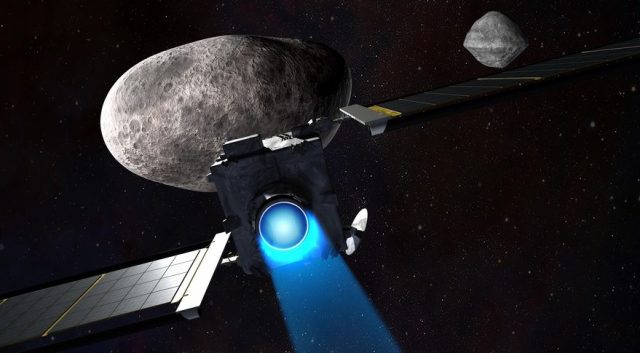IMPACT! NASA Successfully Smashes DART Spacecraft Into Asteroid

Update 7:23 PM EDT: Success!
IMPACT SUCCESS! Watch from #DARTMIssion’s DRACO Camera, as the vending machine-sized spacecraft successfully collides with asteroid Dimorphos, which is the size of a football stadium and poses no threat to Earth. pic.twitter.com/7bXipPkjWD
— NASA (@NASA) September 26, 2022
Our original story continues below.
Earth has been pelted by uncountable space rocks throughout its history, but for the first time, we may have the ability to prevent an impact. NASA is set to test its asteroid deflection technology for the first time some 6.8 million miles away. That’s where the DART (Double Asteroid Redirection Test) is lining up for its strike on the smaller of two asteroids later today. And you’ll be able to watch it happen.
DART is not a complex spacecraft, nor is it the most expensive, with a total cost of a little over $300 million. It launched in late 2021 aboard a SpaceX Falcon 9 rocket. Almost all the mission hardware is going to obliterate itself at 7:14 PM ET today when the thrusters align for an impact on Dimorphos, the smaller satellite in orbit of 65803 Didymos.
While Didymos is almost a kilometer in diameter, Dimorphos (previously known as Didymoon) is just 170 meters across. These asteroids cross Earth’s orbit, making them potentially dangerous, but the close association of this orbiting pair makes for an excellent test of asteroid redirect technology. Since 65803 Didymos is not aimed at Earth, we don’t want to perturb it in any way that could push it into a future impact, however unlikely. But we can knock around Dimorphos as much as we want without substantial risk.
[embedded content]
So, that’s the plan: DART will drop off a cubesat to observe its swan song, and then it’ll rocket into the surface of Dimorphos. NASA will analyze how the asteroid satellite’s orbit changes following the impact, which will help us refine the requirements for redirecting a true threat to Earth. The European Space Agency (ESA) is also planning a follow-up mission to Didymos-Dimorphos in several years to gather more data. We’re still learning a lot about asteroids, so the effects of the impact are difficult to predict. Some recent work on asteroid composition suggests many objects could be more akin to sticky rubble piles rather than mountains floating in space. Thus, it’s possible DART could have a more dramatic effect on Dimorphos than NASA expected.
You’ll be able to get the story live as it happens today. NASA will stream the event live on its website and YouTube channel (above). You’ll also be able to follow along on Twitter and Facebook. The agency plans to begin live coverage at 6 PM ET today.
Now read:

Comments are closed.